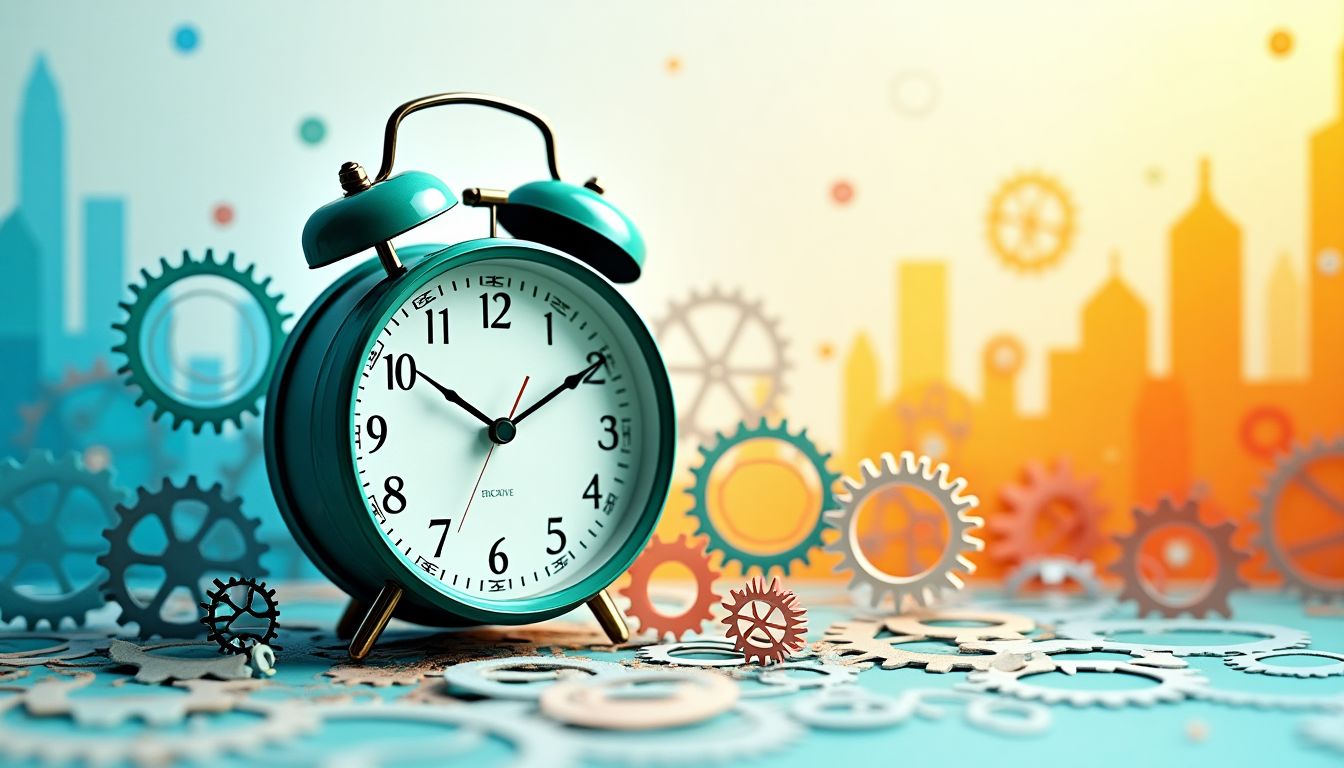The antidote to exhaustion isn’t rest. It’s whole-heartedness. – David Whyte. This powerful statement resonates deeply as we find ourselves in a world brimming with relentless hustle and ever-increasing demands. In the quest for productivity, we often lose sight of what truly nourishes our spirit—time spent intentionally, savoring the moment. Like Whyte suggests, perhaps it is time for a recalibration; one that moves us from the chaotic, hamster-wheel existence to a more balanced approach. As the world inches closer to the dawn of Artificial General Intelligence (AGI), we have a unique opportunity to redefine our relationship with time itself. Are we at the edge of liberation or merely stepping into another cycle of busyness?
The pressure to constantly hustle has become so normalized that many of us wear our exhaustion like a badge of honor. Authors like Tim Ferriss, with his exploration of the ‘4-Hour Workweek,’ have challenged traditional notions of productivity. Meanwhile, thinkers like Cal Newport advocate for ‘Deep Work,’ encouraging us to focus meaningfully rather than multiply our distractions. Meanwhile, noted psychologist Angela Duckworth in her book 'Grit' sheds light on how perseverance—the grind—can fuel success. But if we dive a little deeper, is it really about grinding harder or finding clarity in stillness? The looming arrival of AGI compels us to examine these beliefs and perhaps catalyze a profound shift in the way we live our lives.
The complexities of our modern workspace bring us to a crucial crux: with AGI on the horizon, will we seize the chance to reclaim our time or surrender it to yet another cycle of productivity? This could be our moment to rethink the hustle culture and embrace a philosophy of stillness that brings about true fulfillment and joy.
1. The Rise of Hustle Culture: Roots and Impacts
1.1 Historical Context of Hustle Culture
The hustle culture didn’t sprout overnight like a pretty weed in a nursery. Its roots trace back to the Industrial Revolution. This was a time when society idolized hard work and never-ending productivity. Imagine folks clunking away at machines, fueled by steam and ambition! Over the decades, this glorification of busyness took shape, churning out the belief that if you weren’t busy, you were, well, lazy. Skip a lunch break? That's a noble sacrifice! The implications? We’ve created a cyclical treadmill of work that spins faster with each passing year. Trust me, those are not the good kind of cardio workouts.
1.2 Psychological and Societal Impacts
But the relentless chase for “more” hasn’t come without consequences. Cue the dramatic music! Anxiety, stress, and burnout have become the modern-day villains lurking in the shadows of our constant hustle. Studies reveal that over 70% of employees experience symptoms of burnout at some point in their careers. Can we really measure a person’s worth by their output? It puts unnecessary pressure on people to equate self-worth with performance. It's not just a career crisis; it’s a full-blown existential panic! We need to remember—a well-lived life isn't just about checking off tasks on a to-do list; it’s about flourishing through engagement, creativity, and of course, some well-deserved stillness. After all, just because you're busy doesn’t mean you’re achieving anything meaningful!
2. The Push for a New Paradigm: Stillness as Resistance
2.1 The Philosophy of Stillness
Let’s face it: the world can often feel like a wild hamster wheel spinning out of control! We race through our days, rarely stopping to breathe. But what if I told you that stillness is the secret weapon we’ve been overlooking? Drawing from practices like mindfulness in Buddhism, stillness encourages us to embrace our surroundings without the noise of endless distractions. Remember the last time you took a walk in nature? Those moments of quiet connection can recharge our spirits more than any coffee in the world!
2.2 Cultural Movements Towards Minimalism
While we’re all hustling away, some brave souls are embracing minimalism, which seems to contradict our busy lifestyles! Minimalism is all about saying "no" to clutter and distractions and "yes" to intentional living. Think Marie Kondo with a Zen twist! Anecdotes of people who traded in their overflowing schedules for simpler, more fulfilling lives pop up all over the place. Websites like Becoming Minimalist showcase journeys that champion presence and reduce the chaos. When we choose stillness, we start to reclaim what really matters in life: experiences, connections, and, well, joy!
3. AGI's Role in Transforming Work: Opportunities and Threats
3.1 Eliminating Repetitive Tasks
As we step into the realm of Artificial General Intelligence (AGI), we find an exciting promise: we could wave goodbye to those mind-numbing, repetitive tasks! Imagine a world where “busy work” only exists in your memory, like that haircut you thought was a good idea back in high school. AGI’s ability to automate those dull tasks frees us up for creative endeavors. Suddenly, our work feels less like a chore and more like a chance to unleash our inner Picasso or Steve Jobs!
3.2 Redefining Workforce Dynamics
With AGI in the scene, the traditional 9-to-5 grind begins to look a bit outdated—like a flip phone at a tech conference. Companies are more likely to embrace flexible hours, allowing us to find rhythms that suit our individual styles. That means no more awkwardly staring at the clock waiting to leave at 5 PM (or, let’s be honest, 4:55 PM!). Instead, organizations might shift toward a model that values productivity over mere presence. It’s about time, right? You might soon work at hours that generate the best version of you, and who knows, it could even lead to everyone singing “Kumbaya” while efficiently completing tasks. A cultural revolution is just around the corner!
4. Reassessing Productivity in the Age of AGI
4.1 Quality vs. Quantity
In our fast-paced world, we've often been led to believe that being busy is the same as being productive. Society tends to measure success by how many tasks we can check off a list in a day. But as we step into the age of AGI, it's time to challenge this idea. Think about it: when was the last time you felt genuinely fulfilled by mindlessly ticking boxes? It's kind of like running on a treadmill – lots of movement, but no real progress.
AGI could change how we view productivity. With robots and algorithms taking care of mundane tasks, we can shift our focus to meaningful activities. Productivity should be about quality. Here's how AGI can help:
- Eliminate unnecessary tasks: AGI can handle repetitive chores, allowing us to focus on creative projects that inspire us.
- Encourage thoughtful contributions: Instead of cramming more work into our schedule, we can choose tasks that truly resonate with our passions and goals.
- Foster innovation: By freeing up time, AGI can help us explore new ideas and solutions, enhancing our overall efficiency.
4.2 The Role of Time as a Resource
It's time to rethink how we view time. Traditionally, we think of it as a linear resource, like a pie that we slice up into work, leisure, and rest. However, in this new paradigm, we must view time qualitatively. It’s about how we spend that time, not just the amount we put in. Quality time enhances our life experiences and nourishes creativity.
To illustrate this, let's consider a few key points:
-
Doing Nothing Can Be Powerful: We've been conditioned to see every moment as needing to be productive. Yet, taking breaks (what some call “doing nothing”) fuels creativity. For example, many famous thinkers, like Albert Einstein, enjoyed downtime to cultivate their ideas.
-
Investing in Experiences: Quality time spent with friends, family, or pursuing hobbies brings joy. Think of the time spent hiking a scenic trail or enjoying a thrilling concert. Those experiences offer lasting happiness, far beyond an untouched to-do list.
-
Balancing Activities: Instead of juggling multiple tasks, we can prioritize activities that bring joy, wisdom, and growth. After all, isn't the true measure of our lives based on our experiences?
To make assessing time as valuable as the tasks we undertake, consider the following table summarizing the difference between traditional vs. quality time perception:
| Traditional View of Time | Quality View of Time |
|---|---|
| Linear and segmented | Flexible and integrated |
| Focus on quantity | Focus on experiences |
| Busyness equals success | Meaningful engagement matters |
5. Leisure Redefined: From Escape to Engagement
5.1 The Changing Nature of Leisure
Leisure is not just an escape; it’s becoming a vital part of a fulfilling life. We’ve all seen it: that familiar feeling of burnout from endless deadlines. In the hustle culture, we often forget that time spent unwinding is just as important, if not more so, than the hours spent working. Leisure can now be seen as a canvas for creativity, personal growth, and community connection.
Have you ever taken a walk in a local park or read a good book, only to feel refreshed and energized afterward? This shift in perspective allows us to see leisure as an essential part of being productive. Here’s how leisure has evolved:
- From Passive to Active: Instead of watching TV mindlessly, people are engaging in hobbies, learning new skills, and exploring nature.
- Community Building: Activities like group classes or community events cultivate connections and foster support. Ever joined a local running club or book club? Those connections can be life-changing!
Imagine cutting your work hours to make space for meaningful leisure pursuits. This redefined approach not only enriches our lives but also shapes our communities for the better.
5.2 Community and Connection in Leisure
Leisure time provides opportunities to build community connections. It’s essential for our happiness and well-being. When we engage in leisure activities, we open doors to shared experiences and relationships, leading to a richer life.
-
Shared Activities: Activities like team sports, local festivals, or volunteer work allow people to bond over shared interests. Just think about the joy of cheering for a local sports team, like the Los Angeles Lakers!
-
Online Communities: In today’s digital world, online platforms can connect us globally. Whether through video games, interest forums, or social media, we can build friendships beyond our geographic constraints.
Consider the list below which highlights the benefits of leisure in enhancing our connections and our mental health:
- Reduces Stress: Engaging in joyful activities lowers tension and promotes relaxation.
- Encourages Creativity: Free time allows for exploration and innovation, fostering new ideas.
- Strengthens Bonds: Shared experiences enhance friendships and community ties.
- Enhances Mental Health: Leisure activities can decrease anxiety and promote a sense of belonging.
As we redefine leisure, remember that it’s not merely an escape. Instead, it can be a vital ingredient for a balanced, fulfilled life, reinforcing the messages of connection and engagement that AGI might amplify in our fast-evolving world.
6. AI Solutions: How Would AI Tackle This Issue?
6.1 Processing Human Behavior
Artificial Intelligence can change everything from how we schedule meetings to how we manage our mental health. Imagine an AI-powered application that observes how we spend time daily. It would analyze our habits, offering insights into effective time allocation and helping create a balanced lifestyle. This AI tool could leverage predictive analytics to suggest changes, showing us the impact of our time choices in real-time. By processing human behavior, it not only guides users but helps cultivate healthier relationships with time.
6.2 Automating Contributions
Repetitive tasks drain our creative energy, leaving us feeling burnt out. AGI can take this burden off our shoulders, automating mundane activities. By integrating AI like [Zapier](https://zapier.com) (which automates repetitive tasks) or [IFTTT](https://ifttt.com) (If This Then That), organizations can redirect their focus towards more fulfilling endeavors. For example, AI could manage data entry, calendar scheduling, or customer inquiries, thus allowing employees to concentrate on strategic thinking and innovative projects.
6.3 Feedback Loops
Feedback loops are vital for understanding how we interact with time. AI can be embedded in our daily routines to monitor stress levels and productivity patterns. Programs like [RescueTime](https://www.rescuetime.com) can track time usage and productivity. Utilizing AI, we can create smart systems that automatically adjust our schedules based on stress indicators, work completion rates, or engagement levels. Imagine a scenario where, based on your real-time performance, your AI assistant recommends a brief break, a walk outside, or even prompts for a quick meditation session to recharge.
6.4 Resource Allocation
In today's hustle culture, effective time management trumps the number of tasks. AI tools can optimize personal scheduling, balancing work, leisure, and rest. Through platforms like [Calendly](https://calendly.com), users can allocate adequate time slots for various activities based on their preferences and productivity patterns. This AI-enabled scheduling tool can suggest the best times for deep, focused work or leisure, fostering a healthier relationship with time.
Mapping the Future: Actions Schedule/Roadmap
Day 1:
- Launch a Mindfulness App Initiative: Collaborate with tech companies to develop a mindfulness app that includes guided meditation, breathing exercises, and time tracking. This app should offer daily reminders to engage in mindfulness practices.
Day 2:
- Organize a Time Audit Workshop: Host a workshop teaching participants how to assess their tasks and identify those which can be automated. Include representatives from automation companies, ensuring comprehension of how technology can ease workloads.
Day 3:
- Introduce Structured Creative Time: Implement a company-wide initiative where every employee must set aside three hours bi-weekly entirely for unstructured, creative activities. Encourage forms of engagement that foster innovation, such as brainstorming, art, or nature walks.
Week 1:
- Execute a Personal Review System: Facilitate a personal time usage evaluation, categorizing activities into productive, leisure, and waste. Utilize AI tools like Toggl to track these activities seamlessly.
Week 2:
- Roll out a Task Automation Seminar: Collaborate with industry experts to conduct a seminar on available automation technologies. Cover AI-assisted tools tailored to various roles within the organization.
Week 3:
- Organize a Community Reflection Session: Gather individuals to discuss their findings regarding time management, openness to automation, and personal experiences with technology. Gather insights for future initiatives.
Month 1:
- Initiate a Time Revolution Workshop: Launch community workshops exploring balancing technology and personal time. Share local success stories on redefining work-life dynamics.
Month 2:
- Develop an Online Productivity Exchange: Create a digital platform encouraging users to share productivity tools and best practices involving AI. Foster a community that actively supports others in optimizing their time.
Month 3:
- Review and Revise: Collect feedback from the newly created platforms and evaluate how well individuals have adapted to their suggested schedules. This data should guide future adjustments.
Year 1:
- Conduct broader community assessments to evaluate the live data gathered. Analyze quality of life changes and community well-being improvements based on the time revolution initiatives. Record findings in a shareable report.
Year 1.5:
- Organize National Seminars: Host a series of seminars sharing success stories and encouraging discussions on time reassessment. Partner with organizations like the American Psychological Association to lend credibility.
Year 2:
- Forge Strategic Partnerships: Collaborate with institutions of higher learning, local governments, and businesses to create comprehensive solutions for time reassessment and work-life integration. Consider pilot programs with AI technologies to explore new ways of engaging with time.
Incorporating these action items could lead to a cultural renaissance where individuals, organizations, and communities work together to redefine productivity and leisure, thereby revolutionizing our relationship with time.
Reimagining Our Existence with Time
As we navigate the complexities of a world dominated by hustle culture, we must not forget that time is one of our most precious resources. The advent of Artificial General Intelligence brings us an opportunity to rethink our existence and relationship with time. Imagine a world where we are not constantly trying to squeeze maximum productivity from our lives but instead focus on what truly fulfills us, what connects us with each other, and what allows us to experience creativity and joy.
In moments of stillness, we can truly listen to our hearts and minds, free from the cacophony of incessant activity. The emergence of AGI doesn’t just promise to automate tasks; it presents a chance for humanity to prioritize meaningful connections and a sense of balance. As we integrate AI, consider how each of us has the power to shape this new paradigm. Will we let technology further entrap us in a cycle of productivity? Or will we seize the opportunity to rise above and reclaim our time? This journey starts with small, intentional steps—wherever you are in life, today can be the day you begin to define what truly matters to you. What does a balanced life look like to you? Let’s step into this new chapter together, defining how we spend our time in ways that enrich our lives and uplift our communities.
Frequently Asked Questions (FAQ)
What is hustle culture?
Hustle culture refers to the intense pressure many people feel to be productive all the time. It often emphasizes working long hours and being busy as signs of success. This culture can lead to stress and burnout, making it essential to find a balance between work and personal life. For more on the negative effects, check out the American Psychological Association.
How could AGI change my work-life balance?
AGI, or Artificial General Intelligence, can help automate routine or boring tasks. This means you’ll spend less time on repetitive work and more time on creative projects or relaxing. Automation could shift our focus from doing everything ourselves to enjoying life and pursuing our interests.
What are practical steps to embrace stillness in my life?
Here are some simple ways to start:
- Mindfulness Exercises: Try meditation or breathing exercises for just a few minutes daily.
- Digital Detox: Set aside time to unplug from your devices.
- Plan Your Time: Schedule a specific time for relaxation, just like you would for a meeting.
- Nature Breaks: Spend time outdoors to recharge your mind and body.
Can leisure improve productivity?
Absolutely! Redefined leisure is not just about escaping but recharging. Engaging in fun and relaxing activities can actually boost your focus and energy when you return to work. Think of leisure as a way to refill your creativity tank!
What resources are available to adopt a balanced approach to life and work?
There are many resources to help you find balance:
- Mindfulness Apps: Apps like Headspace and Calm offer guided meditation techniques.
- Workshops: Local community centers often hold workshops on stress management and productivity.
- Online Courses: Websites like Coursera and Udemy have courses on emotional wellness and time management.
- Books: Check out titles like "Essentialism" by Greg McKeown or "The Art of Stillness" by Pico Iyer for deeper insights.
How can I start a conversation about work-life balance in my workplace?
Starting a conversation about balance can feel daunting, but it’s important! Here are some steps:
- Share Your Experience: Briefly talk about your own struggles with work-life balance.
- Suggest Solutions: Offer ideas like flexible work hours or mindfulness breaks.
- Invite Others: Encourage your co-workers to share their thoughts and ideas during meetings.
Why is finding stillness important in today's fast-paced world?
Finding stillness is vital because it allows us to relax, recharge, and reflect. In our fast-paced lives, taking a step back can help us gain clarity and improve our mental health. When we practice stillness, we can nurture our creativity and come back stronger, ready to tackle challenges head-on.
Where can I learn more about AGI and its implications on work?
You can explore resources from organizations like the Future of Life Institute, which focuses on the implications of advanced technologies, including AGI. Additionally, academic articles available through platforms like JSTOR provide research on the topic.
Wait! There's more...check out our gripping short story that continues the journey: Whispers of Elysium
Disclaimer: This article may contain affiliate links. If you click on these links and make a purchase, we may receive a commission at no additional cost to you. Our recommendations and reviews are always independent and objective, aiming to provide you with the best information and resources.
Get Exclusive Stories, Photos, Art & Offers - Subscribe Today!




























Post Comment
You must be logged in to post a comment.